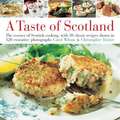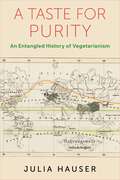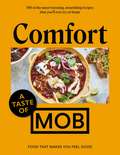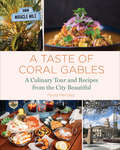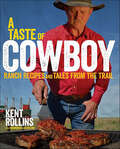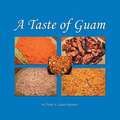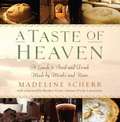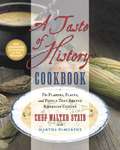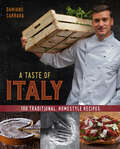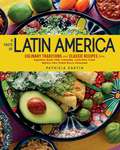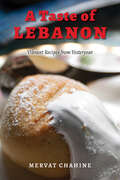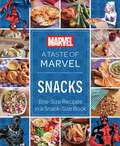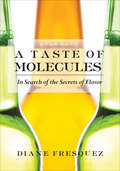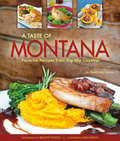- Table View
- List View
A Tangle of Knots
by Lisa GraffDestiny leads 11-year-old Cady to a peanut butter factory, a family of children searching for their own Talents, and a Talent Thief who will alter her life forever. It also includes cake recipes.
A Taste Of Italy: Authentic Italian Recipes
by Bonnie ScottDo you love to eat Italian food? Discover how easy it is to create authentic Italian recipes in your own kitchen. If you enjoy Italian food, this recipe book is for you.
A Taste Of Scotland: The Essence Of Scottish Cooking, With 30 Classic Recipes Shown In 120 Evocative Photographs
by Carol Wilson Christopher TrotterCelebrate the culinary heritage of Scotland in this collection of 30 recipes, featuring authentic dishes from every region, including Roast Young Grouse and Cullen Skink from the Highlands; Traditional Bannocks and Herrings in Oatmeal from Orkney, Shetland and the other islands; as well as Potato Cakes, Kale with Mustard Dressing and Dunfillan Bramble Pudding from the Lowlands and Border country. Over 120 colour photographs illustrate every recipe, with key stages of preparation shown step by step.
A Taste for Absinthe
by Dale Degroff James F. Thompson R. Winston Guthrie Liza GershmanAbsinthe's renaissance is quickly growing into a culinary movement. The "Green Fairy" is now showing up on cocktail menus at chic restaurants around the country. A Taste for Absinthe celebrates this storied and complex liquor by bringing you 65 cocktail recipes from America's hottest mixologists to enjoy as you discover the spirit that has fascinated artists, musicians, and writers for centuries.Absinthe expert R. Winston Guthrie shares the intriguing history of this famous beverage and a wide range of absinthe cocktails crafted by celebrated bartenders such as Jim Meehan of New York's PDT, Erik Adkins of San Francisco's Slanted Door, and Eric Alperin of The Varnish in Los Angeles. In addition to the recipes--such as the Salute to Sazerac (with rye whiskey, Angostura bitters, and lemon peel) and the Green Goddess (fresh basil leaves, cucumber vodka, simple syrup, line juice, and fresh thyme)--you will find: - a primer on the accoutrements (spoons, glasses, fountains) for serving absinthe- a how-to on executing your own absinthe drip- a guide to buying the best-quality absinthe (whether imported or domestic)- a lesson on how to discern between real absinthe and fake - sidebars on absinthe's rich history Whether you want to learn everything you need to know to host "L'Heure Verte" (the Green Hour) and impress your friends with your beautiful accoutrements and practiced pouring technique, or just make a really delicious drink, A Taste for Absinthe will bring you up to speed on the most talked about liquor in history.
A Taste for Love
by Jennifer YenFor fans of Jenny Han, Jane Austen, and The Great British Baking Show, A Taste for Love, is a delicious rom com about first love, familial expectations, and making the perfect bao. <P><P>To her friends, high school senior Liza Yang is nearly perfect. Smart, kind, and pretty, she dreams big and never shies away from a challenge. But to her mom, Liza is anything but. Compared to her older sister Jeannie, Liza is stubborn, rebellious, and worst of all, determined to push back against all of Mrs. Yang's traditional values, especially when it comes to dating. <P><P>The one thing mother and daughter do agree on is their love of baking. Mrs. Yang is the owner of Houston's popular Yin & Yang Bakery. With college just around the corner, Liza agrees to help out at the bakery's annual junior competition to prove to her mom that she's more than her rebellious tendencies once and for all. But when Liza arrives on the first day of the bake-off, she realizes there's a catch: all of the contestants are young Asian American men her mother has handpicked for Liza to date. <P><P>The bachelorette situation Liza has found herself in is made even worse when she happens to be grudgingly attracted to one of the contestants; the stoic, impenetrable, annoyingly hot James Wong. As she battles against her feelings for James, and for her mother's approval, Liza begins to realize there's no tried and true recipe for love.
A Taste for Provence
by Helen Lefkowitz HorowitzProvence today is a state of mind as much as a region of France, promising clear skies and bright sun, gentle breezes scented with lavender and wild herbs, scenery alternately bold and intricate, and delicious foods served alongside heady wines. Yet in the mid-twentieth century, a travel guide called the region a "mostly dry, scrubby, rocky, arid land." How, then, did Provence become a land of desire--an alluring landscape for the American holiday? In A Taste for Provence, historian Helen Lefkowitz Horowitz digs into this question and spins a wonderfully appealing tale of how Provence became Provence. The region had previously been regarded as a backwater and known only for its Roman ruins, but in the postwar era authors, chefs, food writers, visual artists, purveyors of goods, and travel magazines crafted a new, alluring image for Provence. Soon, the travel industry learned that there were many ways to roam--and some even involved sitting still. The promise of longer stays where one cooked fresh food from storied outdoor markets became desirable as American travelers sought new tastes and unadulterated ingredients. Even as she revels in its atmospheric, cultural, and culinary attractions, Horowitz demystifies Provence and the perpetuation of its image today. Guiding readers through books, magazines, and cookbooks, she takes us on a tour of Provence pitched as a new Eden, and she dives into the records of a wide range of visual media--paintings, photographs, television, and film--demonstrating what fueled American enthusiasm for the region. Beginning in the 1970s, Provence--for a summer, a month, or even just a week or two--became a dream for many Americans. Even today as a road well traveled, Provence continues to enchant travelers, armchair and actual alike.
A Taste for Purity: An Entangled History of Vegetarianism (Columbia Studies in International and Global History)
by Julia HauserIn nineteenth-century Europe and North America, an organized vegetarian movement began warning of the health risks and ethical problems of meat eating. Presenting a vegetarian diet as a cure for the social ills brought on by industrialization and urbanization, this movement idealized South Asia as a model. In colonial India, where diets were far more varied than Western admirers realized, new motives for avoiding meat also took hold. Hindu nationalists claimed that vegetarianism would cleanse the body for anticolonial resistance, and an increasingly militant cow protection movement mobilized against meat eaters, particularly Muslims.Unearthing the connections among these developments and many others, Julia Hauser explores the global history of vegetarianism from the mid-nineteenth century to the early Cold War. She traces personal networks and exchanges of knowledge spanning Europe, the United States, and South Asia, highlighting mutual influence as well as the disconnects of cross-cultural encounters. Hauser argues that vegetarianism in this period was motivated by expansive visions of moral, physical, and even racial purification. Adherents were convinced that society could be changed by transforming the body of the individual. Hauser demonstrates that vegetarians in India and the West shared notions of purity, which drew some toward not only internationalism and anticolonialism but also racism, nationalism, and violence. Finding preoccupations with race and masculinity as well as links to colonialism and eugenics, she reveals the implication of vegetarian movements in exclusionary, hierarchical projects. Deeply researched and compellingly argued, A Taste for Purity rewrites the history of vegetarianism on a global scale.
A Taste of . . . Bake Me I'm Yours . . . Sweet Bitesize Bakes: Fun Baking Recipes for Over 25 Tiny Treats (Bake Me I'm Yours . . .)
by Sarah TrivuncicOver twenty-five big ideas for pretty little cakes and pastries from Maison Cupcake founder Sarah Trivuncic. With this gorgeous little book, you will learn how to bake miniature versions of your best-loved desserts, confections, patisserie, and sweet treats with easy-to-follow recipes and expert instructions for essential cake decorating techniques. Discover how to adorn pastries, cupcakes, and cookies with sugarcraft embellishments and fondant icing for stunning results, and how to whip up tasty fillings and toppings, from buttercream and chocolate ganache to marshmallow fluff, lemon curd, and crème patissière. The compact size and gorgeous photography will make it easy for you to choose a pastry or cake design and get baking and decorating straight away, whether you are an experienced cake decorator or a complete beginner! Inside Bake Me I&’m Yours . . . Sweet Bitesize Bakes, you&’ll find delicious recipes and treats for every occasion, including: · Banana whoopie pies · Choux pastry · Fondant fancies · French macarons · Gingerbread cookies · Cupcakes · Madeleines · Mini meringues · Mini pavlovas · Red velvet cakes · Sweet pastry · Vanilla sponge cakes . . . and many more!
A Taste of Adventure
by Exodus Travels LimitedIf you're an adventurer with an appetite, then this cookbook is for you! This lovely cookbook is a collection of globetrotting gastronomy to help you recreate your travels at home.The recipes in this book are from all over the world, from Vietnamese Pho and Indian Mango Lassi, to traditional African flatbreads, Middle Eastern Lamb Tagine, and Spanish Paella.With these recipes you'll have the whole world at your fingertips!
A Taste of Blackberries
by Doris B. SmithA boy's best friend and neighbor suddenly dies from a bee sting allergy. The boy left behind (never named) grieves the loss of his friend. Upper elementary level.
A Taste of Comfort MOB - your free sampler
by MobGrab your three comforting and tasty recipes in this free e-book - a sampler of the eagerly awaited new book from MOB Kitchen. COMFORT MOB celebrates all things crispy, squidgy, cheesy, spicy, warming, sticky, nourishing... all the flavours, textures and feel of comfort pulled together in one place. Hearty dishes from around the world that warm, soothe and fill you. Spending time in the kitchen has never felt so good.In this sampler are the fabulous recipes for: - Meatballs in nduja sauce - The ultimate cheeseburger - Miso sticky toffee puddingIf you've enjoyed creating (and eating!) these recipes, you can pre-order the complete book of 100 recipes now.
A Taste of Coral Gables: Cookbook and Culinary Tour of the City Beautiful
by Paola MendezThis ultimate foodie guide to the Florida city “features more than 70 restaurants, and the recipes reflect the diverse, multicultural culinary landscape” (Mitch & Mel Take Miami).A Taste of Coral Gables is brimming with all the great food and good vibes that make this sunny city in South Florida such a magnet for food lovers of all stripes. Filled with recipes, restaurant descriptions, menu highlights, chef profiles, wine pairings, and more, this one-stop resource on the Coral Gables food scene doubles as a restaurant guide and recipe resource to the best places the city has to offer.There are approximately seventy-five restaurants covered in the book, each with a two-page spread that contains color photographs, informative text on the origins and highlights of the restaurant, what makes it unique, and who the people are behind the restaurant’s unique atmosphere and cuisine. Each also features a recipe for one of the restaurant’s signature dishes for easy preparation at home.From such venerable dining establishments as the Palm d’Or at the Biltmore (haute cuisine in Old-World charm with New World sensibilities) to fun and funky specialty joints such as Ms. Cheezious (grilled cheese in every manner imaginable), to ethnic standouts such as Talavera (down-home Mexican), all bases are covered in this comprehensive culinary treasure trove paying homage to the “City Beautiful.”
A Taste of Cowboy: Ranch Recipes and Tales from the Trail
by Shannon Rollins Kent RollinsIrresistible recipes from pantry ingredients by an authentic cowboy and TV veteran Whether he&’s beating Bobby Flay at chicken-fried steak on the Food Network, catering for a barbecue, bar mitzvah, or wedding, or cooking for cowboys in the middle of nowhere, Kent Rollins makes comfort food that satisfies. This gifted cook, TV contestant, and storyteller takes us into his frontier world with simple food anyone can do. A cowboy&’s day starts early and ends late. Kent offers labor-saving breakfasts like Egg Bowls with Smoked Cream Sauce. For lunch or dinner, there&’s 20-minute Green Pepper Frito Pie, hands-off, four-ingredient Sweet Heat Chopped Barbecue Sandwiches, or mild and smoky Roasted Bean-Stuffed Poblano Peppers. He even parts with his prized recipe for Bread Pudding with Whisky Cream Sauce. (The secret to its lightness? Hamburger buns.) Kent gets creative with ingredients on everyone&’s shelves, using lime soda to caramelize Sparkling Taters and balsamic vinegar to coax the sweetness out of Strawberry Pie. With stunning photos of the American West and Kent&’s lively tales and poetry, A Taste of Cowboy is a must-have for everyone who loves good, honest food and wants a glimpse of a vanishing way of life.
A Taste of Disney: Bite-Size Recipes in a Snack-Size Book
by Insight EditionsEnjoy a taste of Disney with this pocket-size cookbook of snacks inspired by your favorite animated adventures!Celebrate your love of Disney films with this adorable cookbook filled with the most delicious snacks from Insight Editions&’ bestselling Disney and Pixar cookbooks. BITE-SIZE AND DELICIOUS: Tempt your tastebuds with these simple recipes featuring everyday ingredients. Enjoy White Rabbit's Garden Crudité (Alice in Wonderland), Merida Cranachan (Brave), Bare Necessities Banana Muffins (The Jungle Book), Mug of Meat (The Emperor's New Groove), Icicle Cookies (Frozen), and so many more delicious creations to munch on! GREAT GIFT: Perfect for holidays, party hosts, birthdays—and un-birthdays, of course! It's sure to be a delight for any Disney fan BEAUTIFUL AND CUTE: This fully licensed cookbook features gorgeous recipe photos, beautiful styling, and artful appearances of the characters you love
A Taste of Disney: Sippable Recipes in a Pint-Size Book
by Insight EditionsToast your favorite Disney film with this pocket-size recipe book bursting with drinks inspired by your favorite animated adventures!Soak up this adorable recipe book featuring gorgeous, tasty nonalcoholic recipes for delectable drinks from Insight Editions&’ full line of Disney and Pixar best-selling cookbooks. EASY AND DELICIOUS: Raise a glass to this recipe book filled with simple instructions featuring everyday ingredients to brew up delicious drinks for all ages. Enjoy Lu'Au Blue Hawaiian (Lilo & Stitch), Black Forest Hot Cocoa (Snow White and the Seven Dwarfs), Growth Potion (Alice in Wonderland), Tiana Mardi Gras Smoothie (Princess and the Frog), and so many more drinks to sip and savor GREAT GIFT: Perfect for holidays, party hosts, birthdays—and un-birthdays, of course! It's sure to be a delight for any Disney fan BEAUTIFUL AND CUTE: This fully licensed cookbook features gorgeous recipe photos, beautiful styling, and artful appearances of the characters you love
A Taste of Guam
by Paula A. Lujan QuineneThis book includes the author's collection of recipes: Chamorro BBQ, Other Island Favorites, Guam Desserts, Mix of America, and a Treasure Chest of Sweets.
A Taste of Heaven
by Madeline ScherbA fascinating (and mouthwatering!) look at the wonderful food and drink produced by monks and nuns in America, Belgium, France, and Germany. Part travel guide, part cookbook, A Taste of Heaven is a delightful survey of the fine food and drink made by Catholic religious orders in America, Belgium, France, and Germany. From positively scrumptious beer and cheese to some of the richest chocolate on earth, the treats presented in this book are heavenly indeed, and author Madeline Scherb beautifully captures the heart and spirit of the holy work that goes into producing them. With vivid descriptions of the monasteries, their fascinating histories, and helpful advice for travelers on getting there and getting the most out of their visit, this book will serve as an invaluable guide. A Taste of Heaven also contains more than thirty recipes from notable chefs that incorporate the products found at these monasteries, as well as a helpful guide to buying and ordering these delectable ingredients if you are unable to travel to the monasteries themselves. Recipes include such delights as: * Flamiche (a Belgian version of quiche that uses Postel cheese from the Postel Abbey in Belgium) from chef and food columnist Sandy D'Amato * Brownies à la Mode with Trappistine Caramel Sauce (uses caramel from Our Lady of the Mississippi Abbey, Iowa) * Blackberry Cabernet Sorbet (made with Pinot Noir from St. Hildegard Abbey near Rudesheim, Germany) from Ciao Bella Gelateria in Grand Central Terminal, New York City Featuring lovely original black-and-white illustrations that perfectly capture the tranquil atmosphere of the monasteries, A Taste of Heaven is a treasure for anyone who loves spirited food, drink, and travel. .
A Taste of History Cookbook: The Flavors, Places, and People That Shaped American Cuisine
by Walter StaibThe delicious, informative, and entertaining cookbook tie-in to PBS's Emmy Award-winning series A Taste of History. A TASTE OF HISTORY COOKBOOK provides a fascinating look into 18th and 19th century American history. Featuring over 150 elegant and approachable recipes featured in the Taste of History television series, paired with elegantly styled food photography, readers will want to recreate these dishes in their modern-day kitchens. Woven throughout the recipes are fascinating history lessons that introduce the people, places, and events that shaped our unique American democracy and cuisine. For instance, did you know that tofu has been a part of our culture's diet for centuries? Ben Franklin sung its praises in a letter written in 1770!With recipes like West Indies Pepperpot Soup, which was served to George Washington's troops to nourish them during the long winter at Valley Forge to Cornmeal Fried Oysters, the greatest staple of the 18th century diet to Boston's eponymous Boston Cream Pie, A TASTE OF HISTORY COOKBOOK is a must-have for both cookbook and history enthusiasts alike.
A Taste of Home
by Richard HoIn this colorful celebration of culture, community, and the food that binds us all together, follow a young boy on a culinary tour of New York City, perfect for fans of ALL ARE WELCOME and WHERE ARE YOU FROM? What is home? To one child, home is this street he knows better than any other. Where his family has lived for as long as he can remember. But to another…home is also another place. Where she lived when she was a child. Far away, yet close enough in memory. Or maybe home is a place they never saw themselves. That only grandparents or great-grandparents knew. And maybe, home is not a place at all. Maybe home is people, who gather to share, and celebrate. Follow a group of children as they walk through urban streets and meet friends with immigrant parents and grandparents. Together, by picking up ingredients from all around the world, they begin to prepare a shared meal that celebrates the diversity of their city.
A Taste of Italy: 100 Traditional, Homestyle Recipes
by Damiano Carrara&“A well-balanced, deliciously presented cookbook.&” —Shelf AwarenessThe Italian-born, up-and-coming cooking show celebrity brings his passion for Tuscan food to the American table. This beautifully photographed cookbook is alive with vibrant, soul-satisfying food! Growing up in Lucca, Italy, chef Damiano Carrara learned how to cook, not only from his mother and grandmother, but also from his father. Here, he brings those dishes from his family&’s table to yours—including his father&’s tried-and-true recipe for homemade gnocci with pesto. His comforting, delicious recipes range from Pasta e Fagioli (Pasta and Bean Soup) and Insalata di Farro con Gamberi (Farro Salad with Shrimp) to Finocchi Gratinati (Fennel au Gratin), Lasagne Vegetariana ai Carciofini (Vegetarian Baby Artichoke Lasagna), and Panna Cotta scattered with fresh berries or shaved dark chocolate. This is authentic Italian home-style cooking at its best.
A Taste of Latin America: Culinary Traditions and Classic Recipes from Argentina, Brazil, Chile, Colombia, Costa Rica, Cuba, Mexico, Peru, Puerto Rico & Venezuela
by Patricia CartinLatin American food is steeped in history and tradition. From Peru's spicy and citrusy ceviche to hearty Colombian beef, pork, and seafood stews to Argentina's silky, sweet dulce le leche desserts, cooks of all skill levels are invited to discover what make this region's cuisine incomparable. Complete with four-color photographs, expertly crafted recipes and additional insight on the background and customs of each country featured, budding chefs and seasoned experts alike will be enticed by this authentic and unique compilation.
A Taste of Lebanon: Vibrant Recipes from Yesteryear
by Mervat Chahine‘In this book, I bring to life the stories behind the recipes, exploring the culture behind the ingredients and the poetry of their stories through a playful translation of language. It is a fusion of words and food; a cultural education. ‘Each recipe in this collection is inextricably linked to a memory or story from my colourful past; from watching a Lebanese neighbour cooking tomato paste on woodfire to exchanging recipes with my friends at college. My food expands the repertoire of Lebanese cooking by importing from the multicultural melting pot of contemporary London. ‘This is a celebration of seasonal fresh produce, family connections and friendships, and takes you back to basics. Something as simple as “Baked Potato with Kibbeh Spice” is a celebration of ingredients, flavour, and rural village life. This is food to nourish, to share, to enjoy, and to show the healing power that good food has on our lives.’ Mervat Chahine
A Taste of Marvel: Bite-Size Recipes in a Snack-Size Book
by Insight EditionsExperience a taste of Marvel with this adorable, pocket-size cookbook filled with delicious snack recipes from Insight Editions&’ bestselling Marvel cookbooks.Celebrate your love of all things Marvel when you create and enjoy snacks from this adorable cookbook. BITE-SIZE AND DELICIOUS: This pocket-size cookbook is the perfect impulse buy and includes delicious snack recipes from our best-selling Marvel cookbooks, Marvel: Spider-Man: The Official Cookbook, Marvel's Black Panther: The Official Wakanda Cookbook, and Marvel: Cooking with Deadpool. GREAT GIFT: Perfect for holidays, parties, birthdays, movie marathons, study sessions, and more. This cookbook is a delight to give and to receive BEAUTIFUL AND CUTE: This fully licensed cookbook features gorgeous recipe photos and styling to suit Marvel fans of all ages and appetites
A Taste of Molecules: In Search of the Secrets of Flavor (Women Writing Science Ser.)
by Diane FresquezA delicious exploration of what creates the flavors we love—and why our taste buds respond to them—in a fascinating, &“very pleasant and easy read&” (Flanders Today). In this unique scientific study of food, drink, and how the human taste buds sense taste, food journalist Diane Fresquez brings readers along on a journey of gastronomic discovery. She begins by following a Belgian beekeeper who uses science to give the ancient drink of mead (or &“honey wine&”) a modern taste-makeover. Fresquez then travels to Holland to learn how food memories are tested at a research center called the Restaurant of the Future. And elsewhere, she discovers how much skill it takes to make banana flavor in the lab, and experiments on a group of scientists during a surprise meal eaten in the dark. Stuffed with fascinating food facts, anecdotes from the author&’s own culinary life, and a selection of irresistible recipes (including a cocktail with dancing molecules), A Taste of Molecules is an exploration of the senses that will delight foodies and science enthusiasts alike.
A Taste of Montana: Favorite Recipes from Big Sky Country
by Paulette Phlipot Seabring DavisSample Montana's definitive cuisine in A Taste of Montana: Favorite Recipes from Big Sky Country. Davis has compiled 109 recipes from Montana's finest restaurants, resorts, guest ranches, and bed-and-breakfasts. Mouthwatering color photographs by awarding winning photographer Paulette Phlipot complement the delectable recipes. A Taste of Montana includes classic western dishes as well as contemporary cuisine, and, of course, recipes featuring the famous Montana huckleberry. Feast on dishes like Elk Sausage Scramble, Bison Chili, Butte Irish Pasties, Huckleberry-Sour Cream Coffee Cake, and Rustic Flathead Cherry Tart. Davis shares her experiences traveling the nation's fourth largest state visiting chefs, and brings you recipes easy to prepare at home using local, sustainably grown ingredients.


